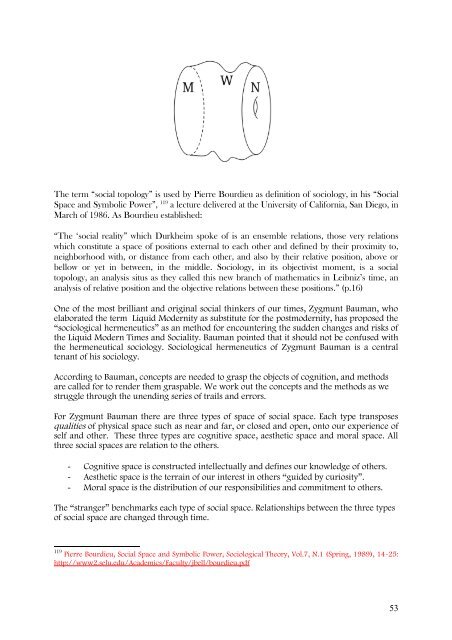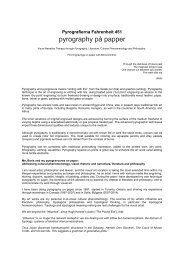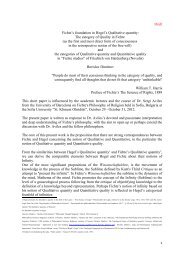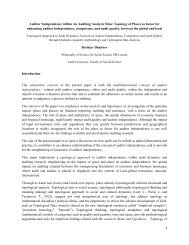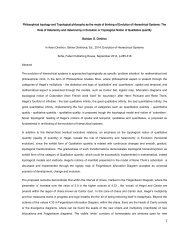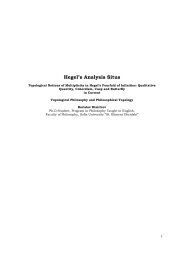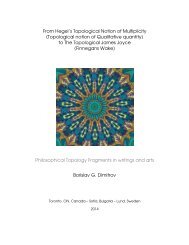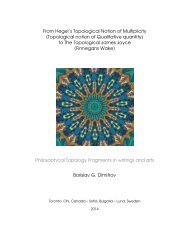Topological Ontology and Logic of Qualitative quantity
Qualitative quantity and BFO (Basic Formal Ontology) of /Barry Smith/ and YAMATO (Yet Another More Advanced Top-level Ontology) of /Riichiro Mizoguchi/
Qualitative quantity and BFO (Basic Formal Ontology) of /Barry Smith/ and YAMATO (Yet Another More Advanced Top-level Ontology) of /Riichiro Mizoguchi/
- No tags were found...
Create successful ePaper yourself
Turn your PDF publications into a flip-book with our unique Google optimized e-Paper software.
The term “social topology” is used by Pierre Bourdieu as definition <strong>of</strong> sociology, in his “Social<br />
Space <strong>and</strong> Symbolic Power”, 119 a lecture delivered at the University <strong>of</strong> California, San Diego, in<br />
March <strong>of</strong> 1986. As Bourdieu established:<br />
“The ‘social reality” which Durkheim spoke <strong>of</strong> is an ensemble relations, those very relations<br />
which constitute a space <strong>of</strong> positions external to each other <strong>and</strong> defined by their proximity to,<br />
neighborhood with, or distance from each other, <strong>and</strong> also by their relative position, above or<br />
bellow or yet in between, in the middle. Sociology, in its objectivist moment, is a social<br />
topology, an analysis situs as they called this new branch <strong>of</strong> mathematics in Leibniz’s time, an<br />
analysis <strong>of</strong> relative position <strong>and</strong> the objective relations between these positions.” (p.16)<br />
One <strong>of</strong> the most brilliant <strong>and</strong> original social thinkers <strong>of</strong> our times, Zygmunt Bauman, who<br />
elaborated the term Liquid Modernity as substitute for the postmodernity, has proposed the<br />
“sociological hermeneutics” as an method for encountering the sudden changes <strong>and</strong> risks <strong>of</strong><br />
the Liquid Modern Times <strong>and</strong> Sociality. Bauman pointed that it should not be confused with<br />
the hermeneutical sociology. Sociological hermeneutics <strong>of</strong> Zygmunt Bauman is a central<br />
tenant <strong>of</strong> his sociology.<br />
According to Bauman, concepts are needed to grasp the objects <strong>of</strong> cognition, <strong>and</strong> methods<br />
are called for to render them graspable. We work out the concepts <strong>and</strong> the methods as we<br />
struggle through the unending series <strong>of</strong> trails <strong>and</strong> errors.<br />
For Zygmunt Bauman there are three types <strong>of</strong> space <strong>of</strong> social space. Each type transposes<br />
qualities <strong>of</strong> physical space such as near <strong>and</strong> far, or closed <strong>and</strong> open, onto our experience <strong>of</strong><br />
self <strong>and</strong> other. These three types are cognitive space, aesthetic space <strong>and</strong> moral space. All<br />
three social spaces are relation to the others.<br />
- Cognitive space is constructed intellectually <strong>and</strong> defines our knowledge <strong>of</strong> others.<br />
- Aesthetic space is the terrain <strong>of</strong> our interest in others “guided by curiosity”.<br />
- Moral space is the distribution <strong>of</strong> our responsibilities <strong>and</strong> commitment to others.<br />
The “stranger” benchmarks each type <strong>of</strong> social space. Relationships between the three types<br />
<strong>of</strong> social space are changed through time.<br />
119 Pierre Bourdieu, Social Space <strong>and</strong> Symbolic Power, Sociological Theory, Vol.7, N.1 (Spring, 1989), 14-25:<br />
http://www2.selu.edu/Academics/Faculty/jbell/bourdieu.pdf<br />
53


